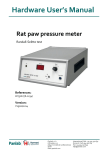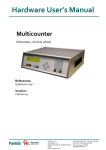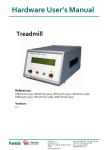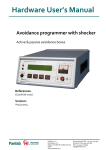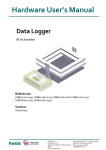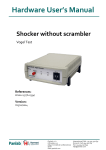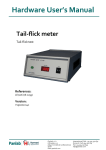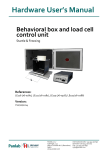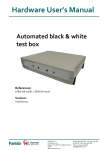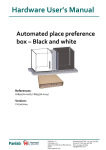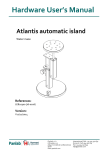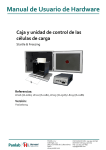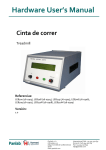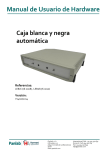Download Hardware User`s Manual Hot plate
Transcript
Hardware User’s Manual Hot plate Hot-plate References: LE7406 (76-0113) Version: V29/10/2014 Panlab, s.l.u C/Energía, 112 08940 Cornellà de Ll.(Barcelona) Spain www.panlab.com International Calls: +34 934 750 697 Domestic Call: 934 190 709 Fax: +34 934 750 699 [email protected] Limitation of Liability PANLAB does not accept responsibility, under any circumstances, for any harm or damage caused directly or indirectly by the incorrect interpretation of what is expressed in the pages of this manual. Some symbols may have more than one interpretation by professionals unaccustomed to their usage. PANLAB reserves the right to modify, in part or in total, the contents of this document without notice. 1. SYMBOLS TABLE Recognising the symbols used in the manual will help to understand their meaning: DESCRIPTION SYMBOL Warning about operations that must not be done because they can damage the equipment Warning about operations that must be done, otherwise the user can be exposed to a hazard. Protection terminal ground connection. Warning about a hot surface which temperature may exceed 65ºC Warning about a metal surface that can supply electrical shock when it’s touched. Decontamination of equipments prior to disposal at the end of their operative life Waste Electrical and Electronic Equipment Directive (WEEE) 2. GOOD LABORATORY PRACTICE Check all units periodically and after periods of storage to ensure they are still fit for purpose. Investigate all failures which may indicate a need for service or repair. Good laboratory practice recommends that the unit be periodically serviced to ensure the unit is suitable for purpose. You must follow preventive maintenance instructions. In case equipment has to be serviced you can arrange this through your distributor. Prior to Inspection, Servicing, Repair or Return of Laboratory Equipment the unit must be cleaned and decontaminated. Decontamination prior to equipment disposal In use this product may have been in contact with bio hazardous materials and might therefore carry infectious material. Before disposal the unit and accessories should all be thoroughly decontaminated according to your local environmental safety laws. Hot plate 2 3. UNPACKING AND EQUIPMENT INSTALATION WARNING: Failure to follow the instructions in this section may cause equipment faults or injury to the user. A. No special equipment is required for lifting but you should consult your local regulations for safe handling and lifting of the equipment. B. Inspect the instrument for any signs of damage caused during transit. If any damage is discovered, do not use the instrument and report the problem to your supplier. C. Ensure all transport locks are removed before use. The original packing has been especially designed to protect the instrument during transportation. It is therefore recommended to keep the original carton with its foam parts and accessories box for re-use in case of future shipments. Warranty claims are void if improper packing results in damage during transport. D. Place the equipment on a flat surface and leave at least 10 cm of free space between the rear panel of the device and the wall. Never place the equipment in zones with vibration or direct sunlight. E. Once the equipment is installed in the final place, the main power switch must be easily accessible. F. Only use power cords that have been supplied with the equipment. In case that you have to replace them, the spare ones must have the same specs that the original ones. G. Make sure that the AC voltage in the electrical network is the same as the voltage selected in the equipment. Never connect the equipment to a power outlet with voltage outside these limits. For electrical safety reasons you only can connect equipment to WARNING power outlets provided with earth connections . This equipment can be used in installations with category II overvoltage according to the General Safety Rules. The manufacturer accepts no responsibility for improper use of the equipment or the consequences of use other than that for which it has been designed. Hot plate 3 PC Control Some of these instruments are designed to be controlled from a PC. To preserve the integrity of the equipment it is essential that the attached PC itself conforms to basic safety and EMC standards and is set up in accordance with the manufacturers’ instructions. If in doubt consult the information that came with your PC. In common with all computer operation the following safety precautions are advised. WARNING • To reduce the chance of eye strain, set up the PC display with the correct viewing position, free from glare and with appropriate brightness and contrast settings • To reduce the chance of physical strain, set up the PC display, keyboard and mouse with correct ergonomic positioning, according to your local safety guidelines. Class A equipment is intended for use in an industrial environment. This equipment has been tested and found to comply with the limits for a Class A digital device, pursuant to part 15 of the FCC rules. These limits are designed to provide reasonable protection against harmful interference when the equipment is operated in a commercial environment. This equipment generates, uses and can radiate radio frequency energy and if WARNING not installed and used in accordance with these instructions, may cause harmful interference to radio communications. Operation of this equipment in a residential area is likely to cause harmful interference in which case the user will be required to correct the interference at his own expense. Hot plate 4 4. MAINTENANCE WARNING: Failure to follow the instructions in this section may cause equipment fault. PRESS KEYS SOFTLY – Lightly pressing the keys is sufficient to activate them. Equipments do not require being disinfected, but cleaned for removing urine, faeces and odour. To do so, we recommend using a wet cloth or paper with soap (which has no strong odour). NEVER USE ABRASIVE PRODUCTS OR DISSOLVENTS. NEVER pour water or liquids on the equipment. Once you have finished using the equipment turn it off with the main switch. Clean and check the equipment so that it is in optimal condition for its next use. The user is only authorised to replace fuses with the specified type when necessary. OPENING FLANGE SWITCH FUSE-HOLDER Figure 1. Power inlet, main switch and fuse holder. FUSE REPLACEMENT OR VOLTAGE SETTING CHANGE In case of an over-voltage or other incident in the AC net making it impossible to turn on the equipment, or if the equipment voltage setting is incorrect, check fuses according to the following procedure. 1 Remove power cord from the power inlet. Hot plate 5 2 Open fuse-holder by pulling the flange with a regular screwdriver. Figure 2. Open fuse-holder door. 3 Extract fuse holder using the screwdriver. Figure 3. Extract fuse-holder. 4 Replace fuses if necessary. Insert fuses in the fuse-holder in the correct position. CORRECT INCORRECT Figure 4. Fuses position. 5 Insert the fuse-holder again, positioning it according to the voltage in the AC net. 115V POSITON 230V POSITION Figure 5 Fuse holder position. 6 If the fuses blow again, unplug the equipment and contact technical service. WARNING For electrical safety reasons, never open the equipment. The power supply has dangerous voltage levels. Hot plate 6 5. TABLE OF CONTENTS 1. SYMBOLS TABLE 2 2. GOOD LABORATORY PRACTICE 2 3. UNPACKING AND EQUIPMENT INSTALATION 3 4. MAINTENANCE 5 5. TABLE OF CONTENTS 7 6. INTRODUCTION 8 6.1. 7. ACCESSORIES SUPPLIED EQUIPMENT DESCRIPTION 9 10 7.1. FRONT PANEL 10 7.2. REAR PANEL 11 8. 8.1. OPERATING THE LE 7406 12 EQUIPMENT CONNECTION 12 8.2. START-UP 8.2.1. SETTING TO THE REQUIRED TEMPERATURE 8.2.2. TESTS WITH ANIMALS 13 14 15 8.3. EQUIPMENT CLEANING 8.3.1. CLEANING THE HOT PLATE 8.3.2. CLEANING THE TRANSPARENT CYLINDER 15 15 15 9. 16 WORKING WITH THE SEDACOM SOFTWARE 9.1. TRANSMISSION PARAMETERS 16 10. TROUBLESHOOTING 17 11. PREVENTIVE MAINTENANCE 18 12. SPECIFICATIONS 19 Hot plate 7 6. INTRODUCTION The LE 7406 is a device used to assess a rodent’s response to pain induced by heating the rodent’s legs. The nociceptive stimulus comes from a metallic surface which is electrically heated in its entirety. The animal is placed on the metallic surface and the latency of the motor response induced by the pain is measured. Figure 6. LE7406 Hot Plate. The stimulation surface can be heated to a temperature (between 45ºC and 62ºC) which is user-selectable, and which the device will maintain constant (± 0.1ºC) throughout the test. The user starts a timer (by pressing a PEDAL) when the animal is placed on the metal surface. Following a period of latency, the animal licks its leg. This reaction is the usual evaluation criterion for the test. The user presses the PEDAL again to cut off the time once the animal's response is visually detected. The response time (determined with a precision of 0.01 sec.) is displayed on an LCD screen until the next test. The information can be transmitted to a serial printer or a PC via an RS 232 communications port and the SEDACOM software (not included, should be purchased separately). WARNING: The temperature of the Hot Plate hot plate is adjustable between 45 °C and 62 °C. In case of broke down a resettable thermal protection system prevents the temperature exceeds 70 º C. Take caution when touching the hot surface. Hot plate 8 6.1. ACCESSORIES SUPPLIED LE 7406 HOT PLATE (1). PEDAL (1). Power supply cable (1). RS-232 connection cable (1). Hot plate 9 7. EQUIPMENT DESCRIPTION 7.1. FRONT PANEL SELECT UP/DOWN ARROWS ºC HEAT PLATE TIMER Figure 7. Front Panel. HEAT: LED that comes on while the unit is in the process of reaching the temperature selected. º C: This screen indicates the present plate temperature. When the SELECT button is pressed the required temperature is displayed. SELECT: Press this button to set the required temperature using the ARROWS. The Up arrow increases the setting temperature and the Down arrow lowers it. The temperature can be set from 45ºC to 62ºC in increments of 0.1ºC. ARROWS: These buttons are used to select the target temperature once the SELECT button has been pressed (with the decimal dot flashing). To validate the selection press the SELECT button again (the decimal dot will not flash and the display will show the present plate temperature). TIMER: The screen indicates the time elapsed from the moment the pedal is pressed (start) until it is pressed again (stop). Hot plate 10 7.2. REAR PANEL PEDAL RS-232 POWER Figure 8. Rear Panel. PEDAL: 6,35mm female jack. The foot switch is connected to this connector. RS-232: DB9 female connector to connect the control unit to the computer serial port. POWER: Power inlet, main switch and fuse holder. Hot plate 11 8. OPERATING THE LE 7406 8.1. EQUIPMENT CONNECTION This illustration features a sample system connection. Figure 9. Equipment connection. The connections and necessary cables are listed in the following table. FROM TO CABLE 1 LE7406 RS-232 PC Com Port RS-232 cable 2 LE7406 Pedal Foot switch 6,35mm jack Hot plate 12 8.2. START-UP When the instrument is switched on (switch to ON), the screen displays the present temperature of the hot plate (between 20ºC and 70ºC). If the temperature is above/below this, the screen will display: “––“. When the button is pressed, the required temperature appears on with a flashing decimal dot. Press the screen ARROWS to modify (increase or reduce) the required temperature. Press the button again to select the required temperature, which will be stored in the device's memory, eliminating the need to adjust it every day. While the required temperature is being modified the plate heating system remains active at the previously set temperature. The LED remains on while the heating system is active. The amount of electrical power applied to the plate is proportional to the difference between the actual and the target plate temperature. Once the required temperature is reached, the led heating. will go off, and the plate will stop When the plate temperature falls below the required temperature due to the heat released into the environment, the heating system switches on automatically until the required temperature is reached again. WARNING: the stability of the plate's temperature does not only depend on the heating control system, but also on environmental conditions. Stability is lower if the unit is in a place where ambient temperature is variable (near an open window, air-conditioning unit, etc.) or if there is a substantial difference between the required temperature and the ambient temperature. Following a brief pre-heating period (between 5 and 10 minutes, depending on the difference between required and present plate temperature), the required temperature should be reached. The unit is now ready to begin testing with animals. The test consists of visually detecting a characteristic motor response in mice when they are placed on a hot plate, that is following a very brief period of exploration the mouse licks its leg. The user measures the time elapsed from when the animal is placed on the plate (start point: the timer is started by pressing the PEDAL once) until it licks its leg (end point: the timer is stopped by pressing the PEDAL again). Hot plate 13 The latency of the response is shown on the seconds. The latency time remains on to run another test. screen to a precision of 0.01 screen until the pedal is pressed again The procedure to be followed is described as follows: 8.2.1. SETTING TO THE REQUIRED TEMPERATURE 1 Switch on the Hot Plate. 2 Press the SELECT button once. The present required temperature will be displayed on screen. 3 The decimal dot flashes, indicating that the value of the required temperature can be modified. 4 Press the UP/DOWN ARROWS to modify the required temperature. 5 Once the new required temperature has been reached, press the SELECT button again. 6 This value will be stored permanently in the unit's memory and will prevail throughout the work session. 7 There is no need to input the required temperature every day, as the value is stored permanently in memory. 8 The led HEAT will remain on while the equipment is heating. 9 Following 5 minutes of pre-heating, the unit is ready for use. Hot plate 14 8.2.2. TESTS WITH ANIMALS 1 Place the experimental animal on the plate, pressing the PEDAL once at the same time. 2 As soon as the animal responds by licking its leg, press the PEDAL once to stop the timer. 3 The screen displays the latency of the response, which will remain until the next test. 4 If the device is not connected to the RS 232 port, write down the latency value. Otherwise the peripheral device (serial printer or PC) will record the value displayed on screen. 5 Remove the animal from the plate and go back to step 1 to repeat the procedure. 8.3. EQUIPMENT CLEANING 8.3.1. CLEANING THE HOT PLATE To clean the hot plate you can use a cloth dampen with water and then dry it with a dry cloth. In case that there would be traces of faeces and urine, you can impregnate the cloth with a soapy solution, then remove the soap residues with a dampen cloth and finally dry it with a dry cloth. WARNING: Before cleaning the Hot Plate unplug it from mains. 8.3.2. CLEANING THE TRANSPARENT CYLINDER WARNING: To clean the transparent cylinder never use alcohol or alcohol derived products, otherwise streaks will appear in clear plastic. To clean the transparent cylinder you can use a slightly dampen cloth and then dry it with a dry cloth. If it is too dirty the cloth can be dampen with a soap solution, then remove the foam with a damp cloth and finally dry it with a dry cloth. Hot plate 15 9. WORKING WITH THE SEDACOM SOFTWARE The purchase of the Sedacom software is needed for transferring the data to a computer (please contact your local sales delegate for more information). The Sedacom software reference is composed by a USB Flash key containing the software Installer, a License for use and Sedacom User’s Manual. Follow next instructions: Please refer to the Sedacom User’s Manual for instructions on how to install and use the software with the present device. A serial port (RS232) communication cable (provided with the present device) is needed for the connection of the present device to the computer in which the Sedacom software is installed. Please refer to the present User’s Manual chapter 8.1 for instructions on how to connect this cable to the device. If the computer does not have any serial port, the RS232/USB adapter is needed (ref. CONRS232USB, contact your local sales delegate for more information) WARNING: the RS232 communication cable provided with the device is used for any connection of the device with associated software (Sedacom, etc.). Even when the device is used without software in first instance this cable is to be preserved and kept in a secure place in case the need of using the system with a software arises in the future. In this last case, if the user lost the cable, a new one should be purchased to his local sales delegate (ref. CONRS232). The warranty duration of this cable is the same than the warranty duration of the device. 9.1. TRANSMISSION PARAMETERS The transmission parameters are as follows: Parameter Rate Start bit Data bits Stop bit Control signals Value 9600 bauds 1 8 1 CTS and RTS Hot plate 16 10. TROUBLESHOOTING This table features instructions to solve the most frequent problems. PROBLEM The equipment does not start up. The equipment does not send data to the program Sedacom. The LE7406 display shows "---" instead of a numeric value. The Hot Plate heats always SOLUTION Ensure that the voltage of mains is the same as that selected in the fuse holder. Check the condition of the fuses. Check that the cable is connected between the RS-232 device and the PC serial port (see Figure 9). Make sure that both the serial port as the device selected in the Sedacom program are correct. The equipment will send data only when you press the pedal and the stopwatch is running, then the time is stopped and is necessary to press the pedal again to start a new measurement. If the temperature is below 20.0 ° C or above 70 ° C the display will not show the temperature but will show "---". If the internal temperature probe does not work, the display will show "---"; in this case contact the technical service. If the internal triac is shorted, the Hot Plate has a protective thermal switch that opens the circuit when the temperature reaches 70 ° C. This can be seen when the equipment continues warming despite the HEAT LED is off. Hot plate 17 11. PREVENTIVE MAINTENANCE EXPERIMENT HOT PLATE CLEANING TRANSPARENT CYLINDER CLEANING CHECK TRANSPARENT CYLINDER PLACING Hot plate 18 12. SPECIFICATIONS POWER SUPPLY Input voltage: Frequency: Fuse: Maximum power: Conducted noise: Equipment start-up time: 115/230V~ 50/60 Hz 2 fuses 5mm*20mm 2A 250V Fast 190W EN55022 /CISPR22/CISPR16 class B <10 min WARMING SPECIFICATIONS Temperature range: Display resolution: Accuracy: Highest temperature: Security switch: 45ºC–62 ºC 0.1 ºC +/-0.3 ºC 70 ºC (without probe feedback) 70ºC TEMPERATURE PROBE Technology: Measurement range showed: Linearity: Accuracy: Active probe 20ºC-70 ºC +/-0.1 ºC +/- 0.1 ºC ENVIRONMENTAL CONDITIONS Operating temperature: Operating relative humidity: Storage temperature: 10°C to +40°C 0% to 85% RH, non-condensing 0°C to +50°C, non-condensing COMUNICATIONS OUTPUT Standard interface: Connector: RS232C Delta 9 contacts female connector TIMER Range Resolution DIMENSIONS Width x Height x Depth: Weight: 0.00s to 999.99s 0.01s 232 mm*124 mm*297 mm 5.31 kg Hot plate 19 DECLARACIÓN DE CONFORMIDAD DECLARATION OF CONFORMITY DECLARATION DE CONFORMITÉ Nombre del fabricante: Manufacturer’s name: Nom du fabricant: Panlab s.l.u. www.panlab.com [email protected] Dirección del fabricante: Manufacturer’s address: Adresse du fabricant: Energía, 112 08940 Cornellà de Llobregat Barcelona SPAIN Declara bajo su responsabilidad que el producto: Declares under his responsibility that the product: Déclare sous sa responsabilité que le produit: HOT PLATE Marca / Brand / Marque: PANLAB Modelo / Model / Modèle: LE 7406 Cumple los requisitos esenciales establecidos por la Unión Europea en las directivas siguientes: Fulfils the essential requirements established by The European Union in the following directives: Remplit les exigences essentielles établies pour l’Union Européenne selon les directives suivantes: 2006/95/EC 2004/108/EC 2012/19/EU 2011/65/EU 2006/42/EC Directiva de baja tensión / Low Voltage / Basse tensión Directiva EMC / EMC Directive / Directive CEM La Directiva de Residuos de Aparatos Eléctricos y Electrónicos (WEEE) / The Waste Electrical and Electronic Equipment Directive (WEEE) / Les déchets d'équipements électriques et électroniques (WEEE) Restricción de ciertas Sustancias Peligrosas en aparatos eléctricos y electrónicos (ROHS) / Restriction of the use of certain Hazardous Substances in electrical and electronic equipment (ROHS) / Restriction de l'utilisation de certaines substances dangereuses dans les équipements électriques et électroniques (ROHS) Directiva mecánica / Machinery directive / Directive mécanique Para su evaluación se han aplicado las normas armonizadas siguientes: For its evaluation, the following harmonized standards were applied: Pour son évaluation, nous avons appliqué les normes harmonisées suivantes: Seguridad / Safety / Sécurité: EMC: FCC: Safety of machinery: EN61010-1:2011 1 EN61326-1:2013 Class A 1 FCC47CFR 15B Class A EN ISO 12100:2010 1 This equipment complies with the limits for class A equipment in accordance with CISPR 11 definition and is classed as a Class A digital device, pursuant to CFR Title 47 part 15 of the FCC Rules and is intended to be used in an industrial environment. En consecuencia, este producto puede incorporar el marcado CE y FCC: Consequently, this product can incorporate the CE and FCC marking: En conséquence, ce produit peut incorporer le marquage CE et FCC: En representación del fabricante: Manufacturer’s representative: En représentation du fabricant: Carme Canalís General Manager Panlab s.l.u., a division of Harvard BioScience Cornellà de Llobregat, Spain 26/06/2014 Hot plate 20 Hot plate 21






















